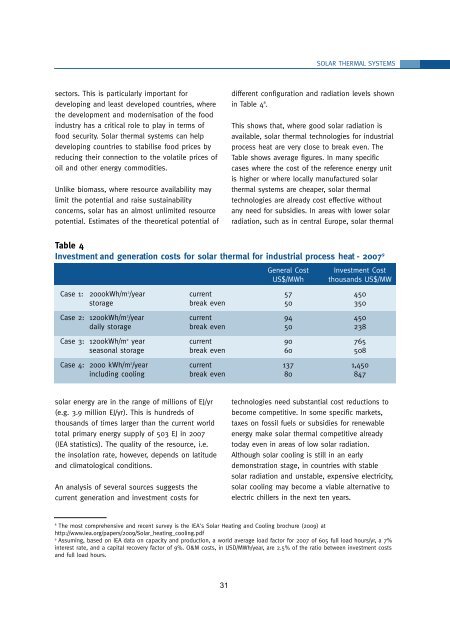Renewable Energy in Industrial Applications â an ... - Unido
Renewable Energy in Industrial Applications â an ... - Unido
Renewable Energy in Industrial Applications â an ... - Unido
Create successful ePaper yourself
Turn your PDF publications into a flip-book with our unique Google optimized e-Paper software.
SOLAR THERMAL SYSTEMS<br />
sectors. This is particularly import<strong>an</strong>t for<br />
develop<strong>in</strong>g <strong>an</strong>d least developed countries, where<br />
the development <strong>an</strong>d modernisation of the food<br />
<strong>in</strong>dustry has a critical role to play <strong>in</strong> terms of<br />
food security. Solar thermal systems c<strong>an</strong> help<br />
develop<strong>in</strong>g countries to stabilise food prices by<br />
reduc<strong>in</strong>g their connection to the volatile prices of<br />
oil <strong>an</strong>d other energy commodities.<br />
Unlike biomass, where resource availability may<br />
limit the potential <strong>an</strong>d raise susta<strong>in</strong>ability<br />
concerns, solar has <strong>an</strong> almost unlimited resource<br />
potential. Estimates of the theoretical potential of<br />
different configuration <strong>an</strong>d radiation levels shown<br />
<strong>in</strong> Table 4 8 .<br />
This shows that, where good solar radiation is<br />
available, solar thermal technologies for <strong>in</strong>dustrial<br />
process heat are very close to break even. The<br />
Table shows average figures. In m<strong>an</strong>y specific<br />
cases where the cost of the reference energy unit<br />
is higher or where locally m<strong>an</strong>ufactured solar<br />
thermal systems are cheaper, solar thermal<br />
technologies are already cost effective without<br />
<strong>an</strong>y need for subsidies. In areas with lower solar<br />
radiation, such as <strong>in</strong> central Europe, solar thermal<br />
Table 4<br />
Investment <strong>an</strong>d generation costs for solar thermal for <strong>in</strong>dustrial process heat - 2007 9<br />
General Cost<br />
US$/MWh<br />
Investment Cost<br />
thous<strong>an</strong>ds US$/MW<br />
Case 1: 2000kWh/m 2 /year current 57 450<br />
storage break even 50 350<br />
Case 2: 1200kWh/m 2 /year current 94 450<br />
daily storage break even 50 238<br />
Case 3: 1200kWh/m 2 year current 90 765<br />
seasonal storage break even 60 508<br />
Case 4: 2000 kWh/m 2 /year current 137 1,450<br />
<strong>in</strong>clud<strong>in</strong>g cool<strong>in</strong>g break even 80 847<br />
solar energy are <strong>in</strong> the r<strong>an</strong>ge of millions of EJ/yr<br />
(e.g. 3.9 million EJ/yr). This is hundreds of<br />
thous<strong>an</strong>ds of times larger th<strong>an</strong> the current world<br />
total primary energy supply of 503 EJ <strong>in</strong> 2007<br />
(IEA statistics). The quality of the resource, i.e.<br />
the <strong>in</strong>solation rate, however, depends on latitude<br />
<strong>an</strong>d climatological conditions.<br />
An <strong>an</strong>alysis of several sources suggests the<br />
current generation <strong>an</strong>d <strong>in</strong>vestment costs for<br />
technologies need subst<strong>an</strong>tial cost reductions to<br />
become competitive. In some specific markets,<br />
taxes on fossil fuels or subsidies for renewable<br />
energy make solar thermal competitive already<br />
today even <strong>in</strong> areas of low solar radiation.<br />
Although solar cool<strong>in</strong>g is still <strong>in</strong> <strong>an</strong> early<br />
demonstration stage, <strong>in</strong> countries with stable<br />
solar radiation <strong>an</strong>d unstable, expensive electricity,<br />
solar cool<strong>in</strong>g may become a viable alternative to<br />
electric chillers <strong>in</strong> the next ten years.<br />
8<br />
The most comprehensive <strong>an</strong>d recent survey is the IEA's Solar Heat<strong>in</strong>g <strong>an</strong>d Cool<strong>in</strong>g brochure (2009) at<br />
http://www.iea.org/papers/2009/Solar_heat<strong>in</strong>g_cool<strong>in</strong>g.pdf<br />
9<br />
Assum<strong>in</strong>g, based on IEA data on capacity <strong>an</strong>d production, a world average load factor for 2007 of 605 full load hours/yr, a 7%<br />
<strong>in</strong>terest rate, <strong>an</strong>d a capital recovery factor of 9%. O&M costs, <strong>in</strong> USD/MWh/year, are 2.5% of the ratio between <strong>in</strong>vestment costs<br />
<strong>an</strong>d full load hours.<br />
31

















